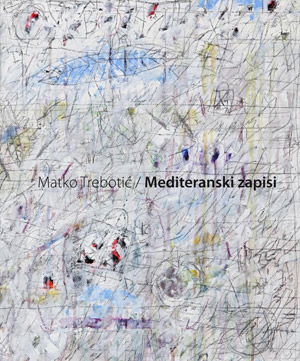|
Matko Trebotić / Mediterranean Memos
Department of Prints and Drawings
7.12.2011.-13.1.2012.
Trebotić’s new paintings are marvellous landscapes as seen by a lonely flyer. In them, Adriatic islands bathe in the light following a summer flood. Abstract compositions with a random sign here and there; a live, dynamic pencil drawing; a thick tissue of verticals developed by the dripping of colours and fluids. A product of both aspiration and coincidence. In this process, in which watercolours and oil, charcoal and pastel, interfuse, the painter believes in and becomes open to his senses, he yearns and dreams. Words and pictures sink to the very edge of legibility. Forms emerge from colours, stains, drops, and gestual brush strokes. In this exciting and expressive flood of forms and colours, self-confidence, a sense of measure and charm are present. Furthermore, a minutely detailed, clear and legible signature of Matko Trebotić, an elegant and a barely visible sign, is present there as well.
Trebotić's drawing represents neither a rudiment nor an idea for the realisation of a painting; it is not texture in itself, though it may be sensed in the texture of the painting. The drawing lives in the very cuticle of the painting and dominates over its entire space; it speaks about the intimate life of the artist, about the sparkle of its being, more than any painter’s composition could. The artist’s joy of life vibrates in the painter’s tissue. It is also a product of deep impressions that are continuously growing in the psyche; they find their peace as quickly as thoughts themselves within the very cadre of the paintings.
This art of painting resembles to a certain extent the conception of painting and drawing as found in the work of the recently deceased Cy Twombly.
Fascinated by the heritage of a foreign country, the beauty and the lightness of the Mediterranean, his art too is a product of remembrance, of the memory
of space, whilst the drawing represents the reflection of this memory. Writing, continual moving in the picture and erasing are his medium, too. He also creates
under the influence of the Mediterranean tradition and climate, which profoundly nurtured and inspired Trebotić’s imagination as well. Despite the same inspiration,
and the conception of painting even, their respective characteristic styles are very personal marks, the reflections of each of their personal sensualities. I do not believe that Twombly’s works themselves had caused
the change, or the flood, that occurred in the paintings of Trebotić’s new cycle. As in many other events, the energies met and recognised each other; each of them emanate authentic light in their respective climates.
The works from the cycle entitled Mediteran Ljeto 11 (Mediterranean Summer 11) stress the painter’s qualities: the dazzling life of the colours, the sediment, the fluid watercolours that drip and pour out, the stains,
and the painter’s gestual strokes. The drawing becomes partly jammed in the density of the painter’s tissue, and ends up by being displaced from the centre of the painting.
From the Foreword by Slavica Marković
|

|